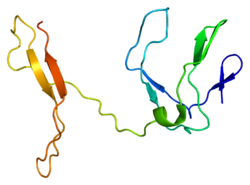Top Qs
Timeline
Chat
Perspective
RELB
Protein-coding gene in the species Homo sapiens From Wikipedia, the free encyclopedia
Remove ads
Transcription factor RelB is a protein that in humans is encoded by the RELB gene.[5]
Remove ads
Interactions
RELB has been shown to interact with NFKB2,[6][7] NFKB1,[6] and C22orf25.[8]
Activation and function
Summarize
Perspective
In resting cells, RelB is sequestered by the NF-κB precursor protein p100 in the cytoplasm. A select set of TNF-R superfamily members, including lymphotoxin β-receptor (LTβR), BAFF-R, CD40 and RANK, activate the non-canonical NF-κB pathway. In this pathway, NIK stimulates the processing of p100 into p52, which in association with RelB appears in the nucleus as RelB:p52 NF-κB heterodimers. RelB:p52 activates the expression homeostatic lymphokines,[9] which instruct lymphoid organogenesis and determine the trafficking of naive lymphocytes in the secondary lymphoid organs.
Recent studies has suggested that the functional non-canonical NF-κB pathway is modulated by canonical NF-κB signalling. For example, syntheses of the constituents of the non-canonical pathway, viz RelB and p52, are controlled by canonical IKK2-IκB-RelA:p50 signalling.[10] Moreover, generation of canonical and non-canonical dimers, viz RelA:p50 and RelB:p52, within the cellular milieu are mechanistically interlinked. These analyses suggest that an integrated NF-κB system network underlies activation of both RelA and RelB containing dimer and that a malfunctioning canonical pathway will lead to an aberrant cellular response also through the non-canonical pathway.
Most intriguingly, a recent study identified that TNF-induced canonical signalling subverts non-canonical RelB:p52 activity in the inflamed lymphoid tissues limiting lymphocyte ingress.[11] Mechanistically, TNF inactivated NIK in LTβR‐stimulated cells and induced the synthesis of Nfkb2 mRNA encoding p100; these together potently accumulated unprocessed p100, which attenuated the RelB activity. A role of p100/Nfkb2 in dictating lymphocyte ingress in the inflamed lymphoid tissue may have broad physiological implications.
Remove ads
See also
References
Further reading
Wikiwand - on
Seamless Wikipedia browsing. On steroids.
Remove ads






